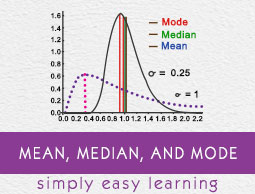
- Mean, Median, and Mode
- Home
- Mode of a Data Set
- Finding the Mode and Range of a Data Set
- Finding the Mode and Range from a Line Plot
- Mean of a Data Set
- Understanding the Mean Graphically: Two bars
- Understanding the Mean Graphically: Four or more bars
- Finding the Mean of a Symmetric Distribution
- Computations Involving the Mean, Sample Size, and Sum of a Data Set
- Finding the Value for a New Score that will yield a Given Mean
- Mean and Median of a Data Set
- How Changing a Value Affects the Mean and Median
- Finding Outliers in a Data Set
- Choosing the Best Measure to Describe Data
Computations Involving the Mean, Sample Size, and Sum of a Data Set
In this lesson, we solve problems involving, the sample size, sum of a data set and it’s mean. Any two of these three quantities are given and we find the third unknown quantity using the relation between these 3 quantities.
Formula
$Mean = \frac{Sum \:of \:the\: data}{Number \:of \:data}$
Sum of the data = Mean × Number of data
$Number\: of\: data = \frac{Sum \:of \:the \:data}{Mean}$
The average of x and 3 is equal to the average of x, 6 and 9. Find x
1, 1, 4, 4, 5, 6, 7, 7, 10, 10
Solution
Step 1:
Average of x and 3 = $\frac{(x+3)}{2}$
Average of x, 6, and 9 = $\frac{(x+6+9)}{3}$
Step 2:
Given $\frac{(x+3)}{2} = \frac{(x+15)}{3}$
Solving we get 3x + 9 = 2x + 30 or
3x – 2x = x = 30 – 9 = 21
Step 3:
So x = 21
7 consecutive even integers have an average of 48. Find the average of the greatest two of those integers.
Solution
Step 1:
Let the consecutive even integers be
x – 6, x – 4, x – 2, x, x + 2, x + 4, x + 6
Their average = $\frac{(x – 6 + x – 4 + x – 2 + x + x + 2 + x + 4 + x + 6)}{7} = \frac{7x}{7}$ = 48. So X=48
Step 2:
So the numbers are 42, 44, 46, 48, 50, 52, 54
The average of the two greatest of these integers 52 and 54 is (52 + 54)/2 = 53